Furloughs and furlongs. Jobs and jockeys. Payrolls and ponies.
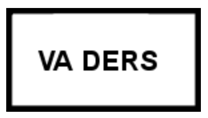
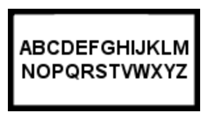
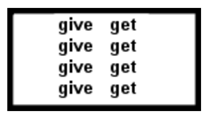
Three rebuses for you on this fine Friday
Answers on last page
Furloughs and furlongs. Jobs and jockeys. Payrolls and ponies.
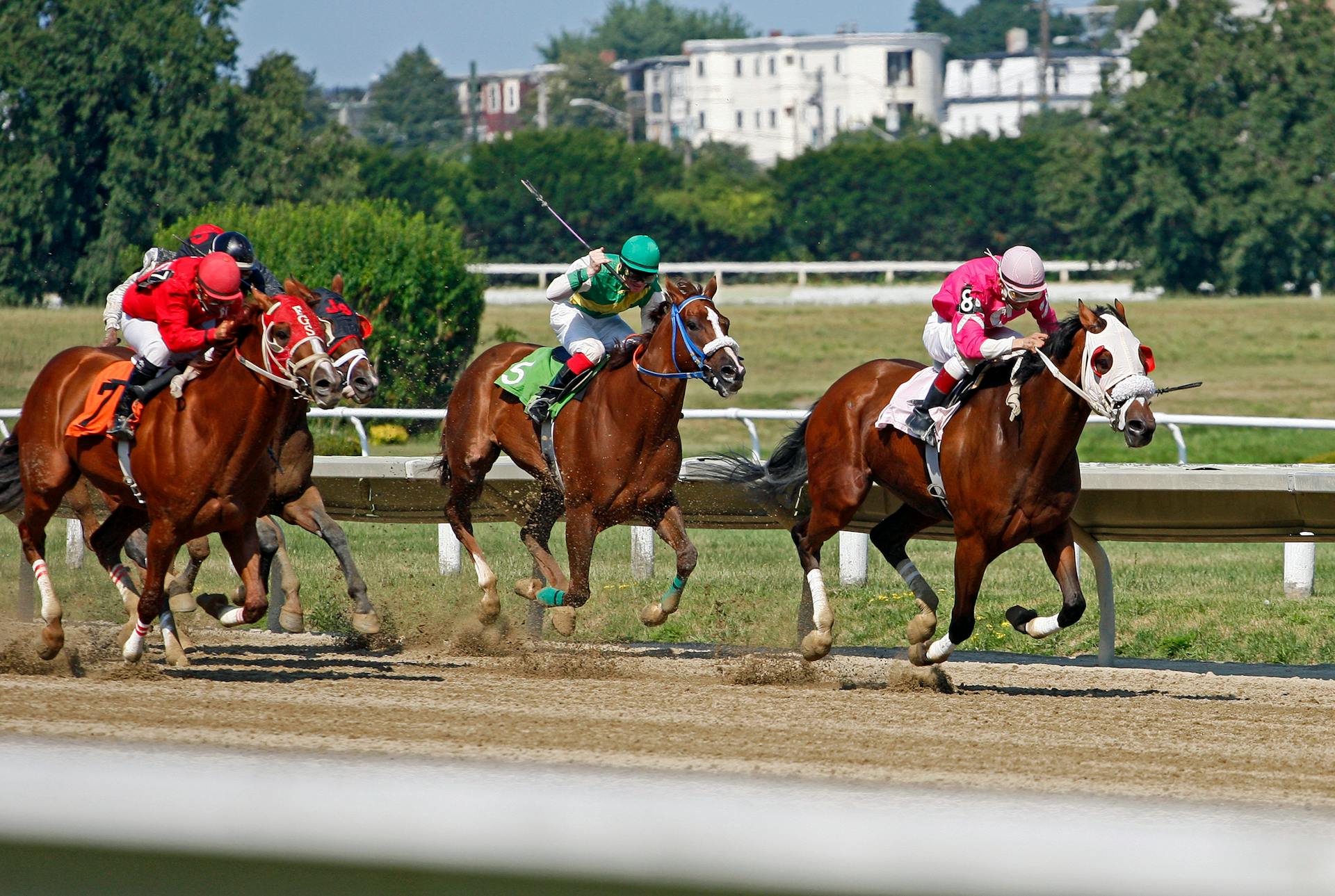



Three rebuses for you on this fine Friday
Answers on last page
Flat
The US jobs report will capture a period about 10 days after the big tariff announcements, so hardly enough time to offer a realistic assessment of their impact. That said, the economy appeared to be slowing down a bit before April 2 as tariff uncertainty started in late January. Therefore, this is not completely useless data. ADP and Jobless Claims were soft this week, and a severely bad jobs report will jangle some nerves. Kalshi and the Bloomberg consensus are both around 135,000. Just about everyone has 4.2% penciled in for the UR, with 6 of 67 economists on each side of the mode, estimating either 4.1% or 4.3%.
Here’s the evolution of the USDJPY vs. yields relationship. One chart goes back to January 2024 and the other one is the same data, starting January 2025. Note the regime break on Liberation Day and recent (modest) return to normal.

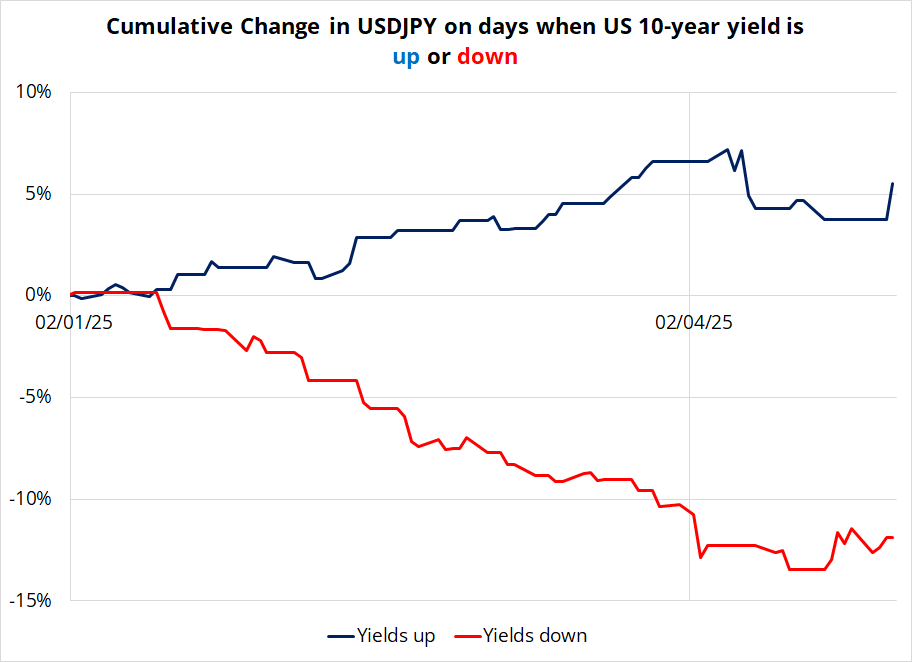
Historically, when you are trying to figure out where USDJPY will go on various NFP results, it’s orthodox and you can estimate X miss or beat in NFP will lead to Y move in USDJPY and Z move in yields. The direction and magnitude are fairly easy to estimate using historical data. But in the current environment, you are not guaranteed to see yields and USDJPY move together. If the bond vigilantes ever come back, we could see a repeat of the EM-style correlation witnessed in mid-April as bonds and the USD sold off in tandem.
My feeling is that we will now toggle between two USDJPY vs. yields regimes:
Which regime we are in depends on what is driving bonds on any given day. If there is a fiscal plan and the market takes it badly by selling bonds, that’s bearish USDJPY. If there’s strong US economic data, and the market sells bonds, that’s bullish USDJPY. Before you can trade any USDJPY vs. yields correlation, you need to think about why bonds are moving.
For example, you can see that yesterday’s weak Initial Claims and stronger ISM both yielded orthodox reactions in both yields and USDJPY.
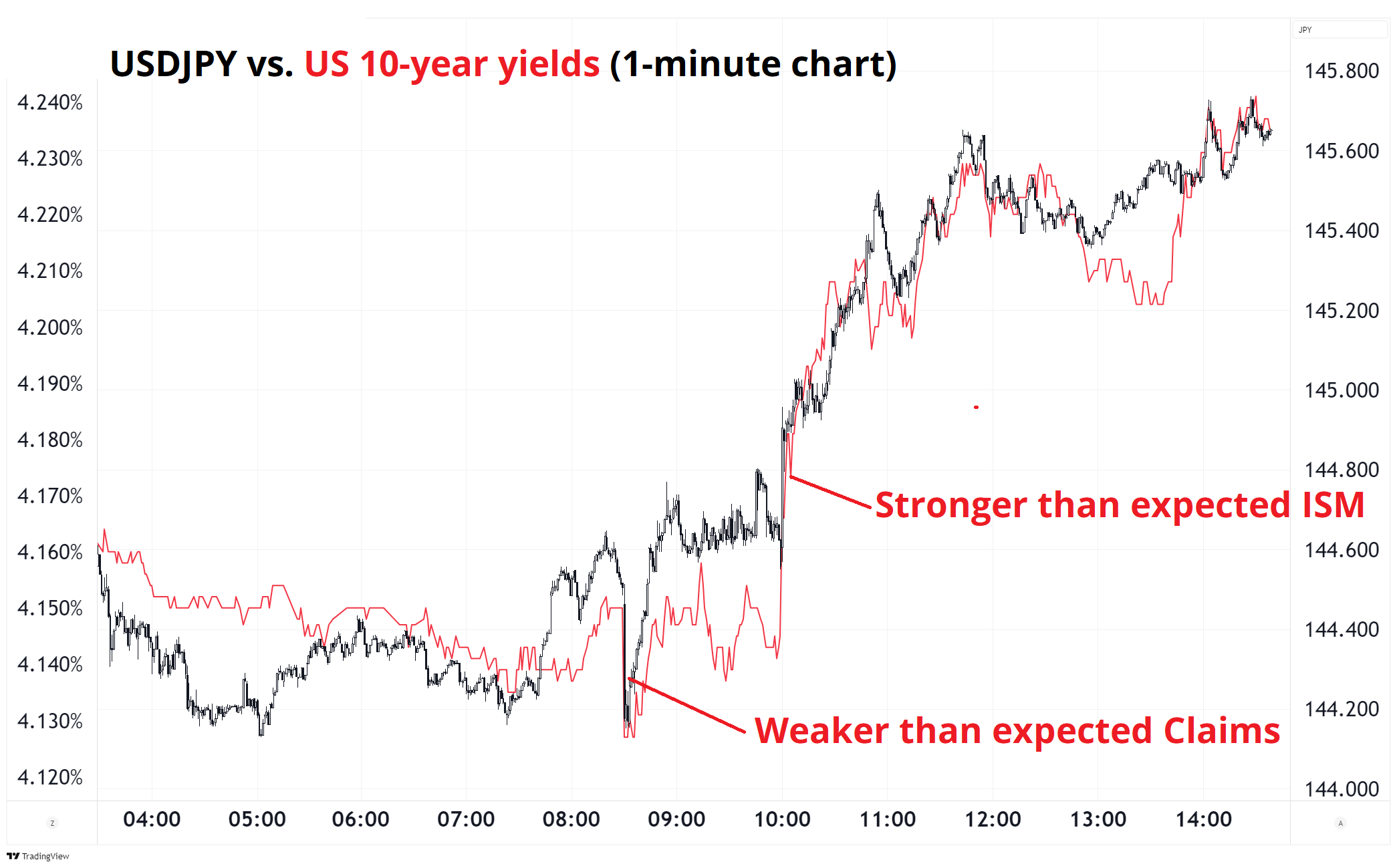
My bet is this continues. So: Normal yields vs. USDJPY relationship around data… Bond vigilante relationship on fiscal announcements and policy fear. For today’s NFP, then, expect a normal sort of reaction where a weak figure will lead to USDJPY selling and vice versa.
Note there could be some complexity around the immigration story and its differing impacts on headline NFP vs. the Unemployment Rate. A tighter labor supply situation may start to push NFP and UR lower as low wage workers are fearful of deportation or have already been deported. Here are my best guesses for market reaction.

The equity relationship to NFP is much more complicated, so I made a grid that includes a bit of commentary. There is some false precision in all these grids, but I wanted to give you my best guess of where different NFP outcomes might take markets. That said, take these point estimates with a grain of salt as I am not implying that forecasts can be so precise.
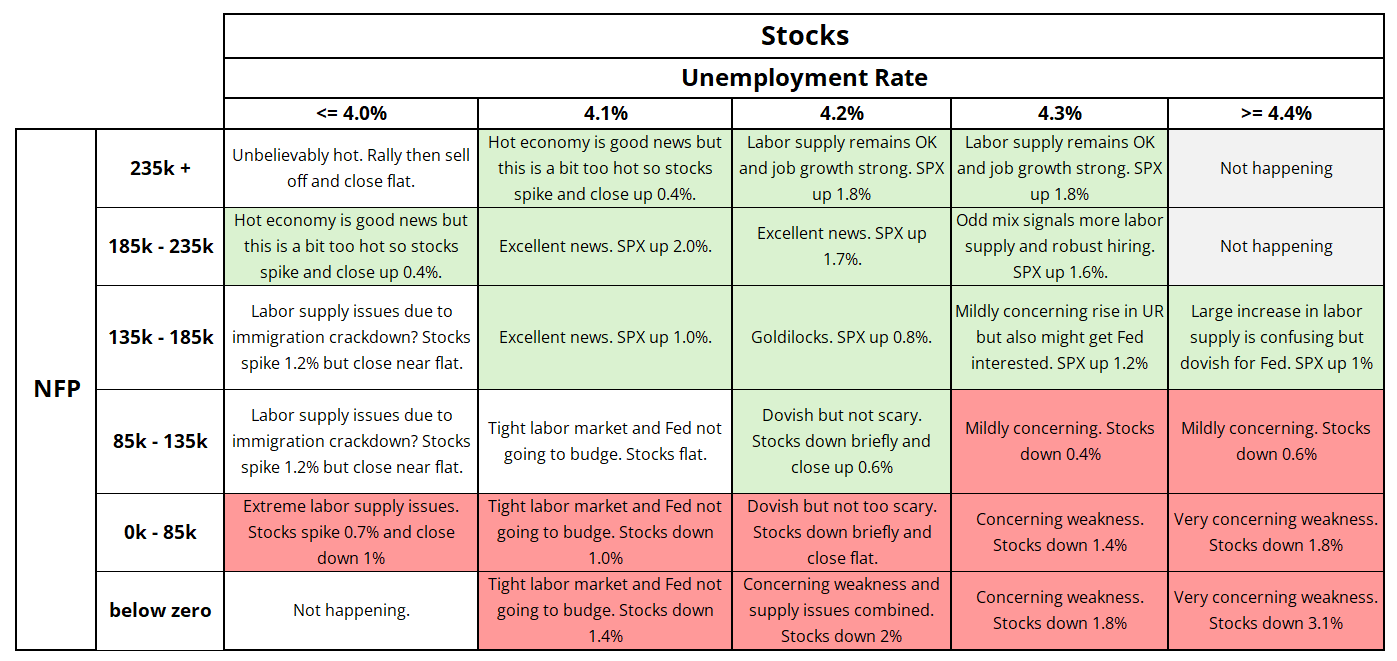
Here is the calendar. I would not normally include Used Car Prices, but that release (9 a.m. Wednesday) might attract a few eyeballs as we look to see any tariff impact. Bill Ackman will be watching for sure because a big part of his thesis on HTZ is that car prices will moon, and their inventory will swell in value. I found the Manheim release date here.
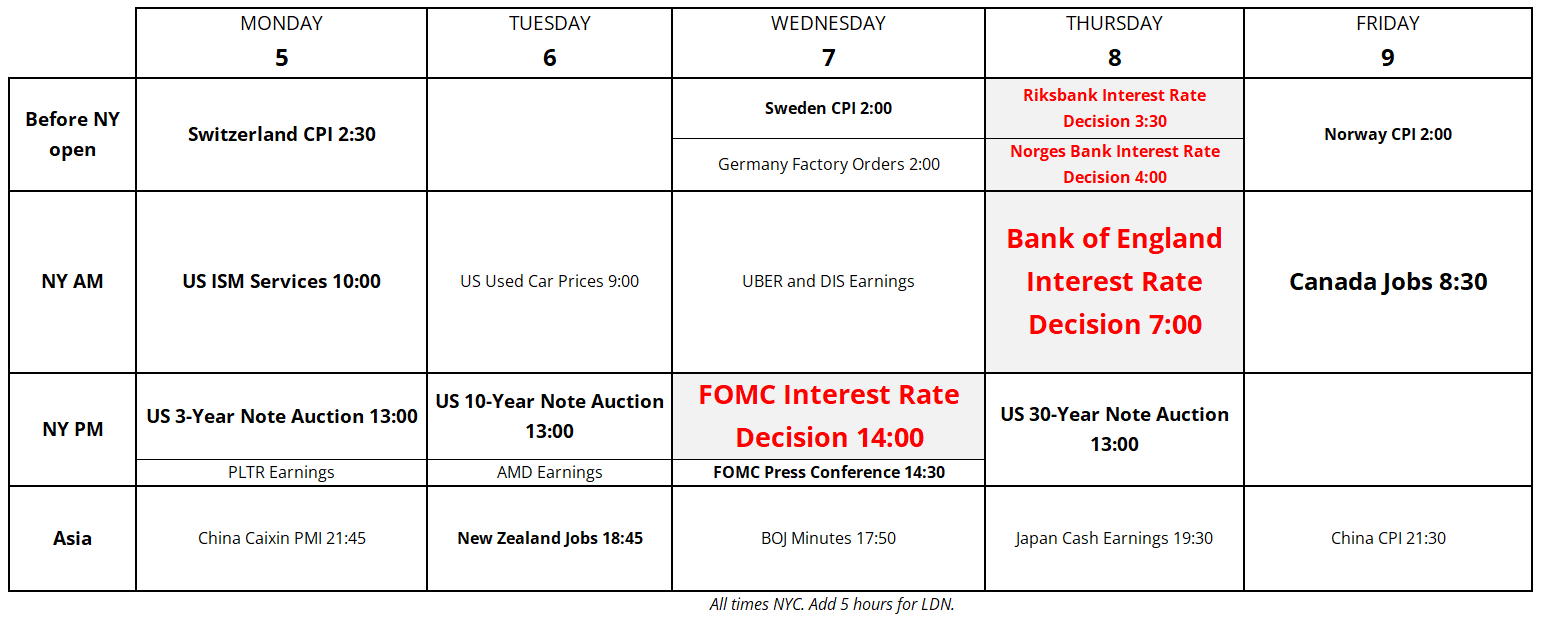
This section is only for anyone interested in the Kentucky Derby.
If you are not interested in horse racing, see you Monday; am/FX is over.
Some of the common languages I speak with my kids are music, Clash Royale, and Magic the Gathering. When I was a teenager, my Dad and I spoke two main common languages: Baseball and horse racing.
So just for the heck of it, let’s talk about the Kentucky Derby. I have been to the races >100 times throughout my life, including two Breeder’s Cups (Miami and Louisville), The Travers Stakes, and about a zillion visits to degen cigar-infested awesomesauce venues like Rideau Carleton Raceway and Connaught Park Raceway in Ontario. Once upon a time, in the year 2000, a group of friends and I even bought a racehorse. It won a single race, then broke its foot… And we quickly learned why long racehorses = short carry.
So, I love the races, and despite betting $200 to win $1618 on various Mystik Dan-heavy bets last year, I can confidently say that I have no edge. Still, there is something romantic about doing the work so that if your bets pay off, you feel like you deserve it. Sure, you can just pick the horse with the coolest-sounding name and win money, but your ego won’t puff up like mine will if I nail the trifecta this year after writing a 1,300-word explanation for my picks!
The hardest thing about the Derby is that the field is ginormous. This isn’t some 5-horse race with a clear favorite paying 4-5 on a sloppy track where you bet the second favorite and pray. This is seven or eight amazing horses in with 12 or 13 other OK-to-meh horses. A jam packed, 20-horse field.
Instead of starting with who I like in The Derby, I start by eliminating who I don’t like.
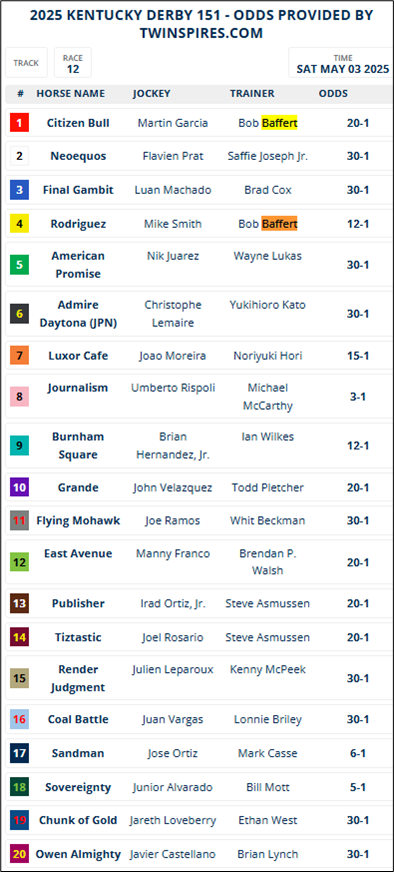
The best horse does not always win the Derby, because you need a great horse and a great trip on the same day. There is a lot of bumping and rubbing in these races, and a horse thrown off kilter usually has trouble getting back on stride. But still, you want to start with the best horses and then hope for a good trip from a decent post.
I start my elimination process by looking at speed. Two good ways to measure horse racing speed are 1) ratings like Beyer, and 2) finishing times, like the last 3/8 and 1/8 of the contenders’ prior races.
Beyer is a pure speed thing and does not account for whether the horse races well at the start, middle, or end, while final stretch times show closing speed, which is as important as overall speed. Closing speed tells you whether the horse will give ‘er on the backstretch in a tight race. 15 of the last 17 Derby winners won with a Beyer Speed Figure of 100 or higher. Yet only two horses in this race have ever posted a Beyer above 100. Note Mystik Dan had a 100 Beyer going in last year; that’s part of why I picked him at 18-1 odds. Here are the two 100+ Beyer scores for horses racing in 2025.
Journalism 108 and 102 (two different races)
Rodriguez 101
(Sandman hit 99; Luxor Café has no Beyer because he hasn’t raced in the USA)
Journalism and Rodriguez also have the highest Brisnet scores. Brisnet is a similar but different way of measuring horse speed. So, they are the clear picks for pure speed. Moving on to closing speed, 10 of the last 13 Kentucky Derby winners (and 20 of the last 27) ran the final 3/8 mile of their prep race before the Derby in under 38 seconds. This is a simplistic measure of closing speed, but a good one. I will eliminate anyone that hasn’t done that.
That leaves seven horses:
Three comments re: that table:
Here’s Journalism, in last place halfway through the race, getting bumped and rubbed like it’s Days of Thunder.
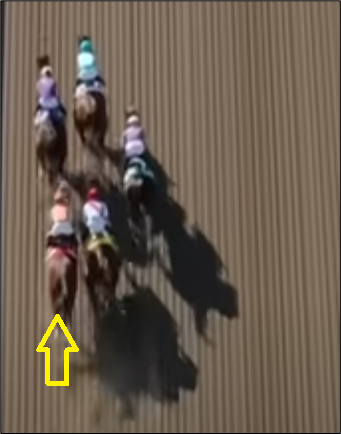
The track surface pattern looks like my corduroy pants from the 1980s
Here is the same moment, different angle. Journalism is the 1 horse at the back.
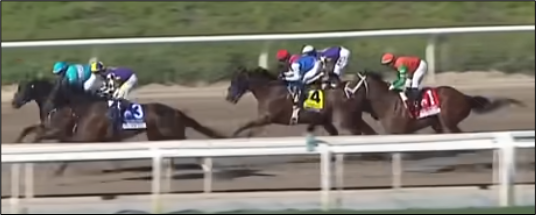
He initiated an impressive comeback to attack from the back of the pack! Huge, speedy win for Journalism.
We have seven horses in that table earlier, so let’s see who else we can eliminate. I want to bet on a maximum of four horses. In a crowded race, post position is super important. Here’s some history that shows which post positions win and are ITM most often at the Derby.
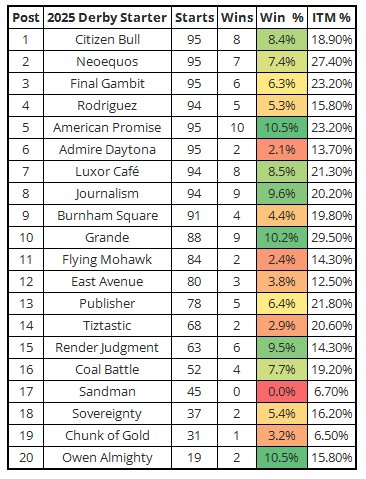
Post position, and some other stuff, are the next criteria for eliminating three more horses. I will eliminate:
OK, so now we are down to four horses. Once I have the horses I like, I look at where they are trading odds-wise. If I love a horse and it’s paying 15-1, that’s a different setup than the same horse at 3-1. Just like in markets, the quality of the bet depends on (probability of success X payoff). So, I try to combine how much I love the horse with how much I love the odds… And then place my bets. Odds at the time of writing are subject to change.
Journalism (3-1) has a nice position (8) and should be on top. He is the best horse in the race. He is not great value at 3-1 in a field of 20 horses, but favorites do win 35% of the time at the Derby and are systematically underbet in horse racing because people overpay for lottery tickets. Journalism is decent, but not amazing value.
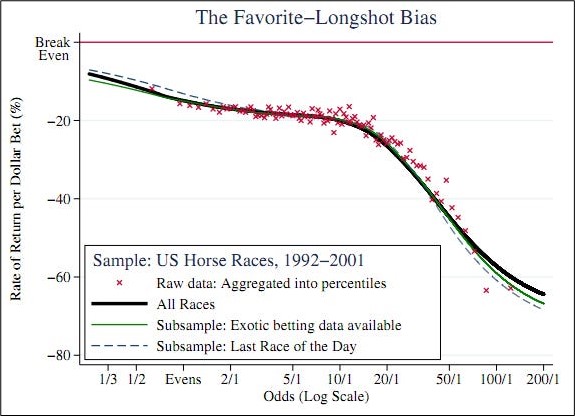
The longer the shot, the more money you should expect to lose
I love Luxor Café (15-1) best as a blend of great horse, and fabulous payout. People used to question the Japanese horses because of the stress of international travel, but last year’s 3-way photo finish included the Japanese horse Forever Young, so maybe travel’s not as big of an issue as we think. Forever Young could easily have won last year’s Derby, as you can see here.
Forever Young (11) loses by a nose-and-a-half to Mystik Dan (3) and Sierra Leone (2)
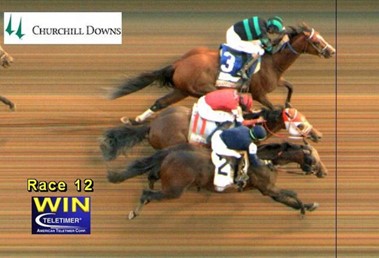
Most importantly (to me)… Luxor Café is a son of American Pharoah, the horse that won the Triple Crown in 2015 (ending a 37-year drought). Good bloodline! Fast horse, excellent pedigree, juicy odds. But I don’t want to bet against Journalism, so I’ll take Luxor Café to place.
Rodriguez’s (12-1) post position is not great, but Mike Smith has 28 Kentucky Derbys under his belt, including two wins (2005 and 2018) and Baffert is the trainer—if anyone can get a trip from the four hole, it’s this duo. Finally, Grande (20-1) has no obvious flaws and runs for Todd Pletcher out of the 10 hole—the best-performing post position over the last 95 Kentucky Derbys.
You can’t pick them all. So, here’s what I am going to do. I think Journalism and Luxor Café are the top two horses, but Journalism is not amazing value at 3-1 compared to Luxor Café at 15-1, so I am putting Journalism in all my exotics but not betting him outright. That way if Journalism wins, the exotics can still hit, and if he gets edged out by Luxor Café, I am rich.
It might rain on Saturday. Luxor Café and his sire (American Pharaoh), plus Rodriguez have performed well on wet tracks.
Here are the exact bets (based on a $250 betting budget):
$78 place #7
$50 exacta box 7/8 (costs $100)
$2 exacta box
4/7/8/10 (costs $24)
$2 trifecta box
4/7/8/10 (costs $48)
Horse racing is negative expected value for almost everyone because the track takes 16%/20%. That’s a substantial vig. So, this is definitely not investment advice, and it’s not even gambling advice.
Have fun! Post time 6:57 p.m. Saturday.

Space Invaders

Missing you

Forgive and forget